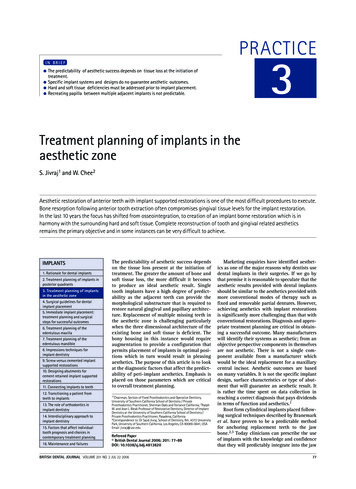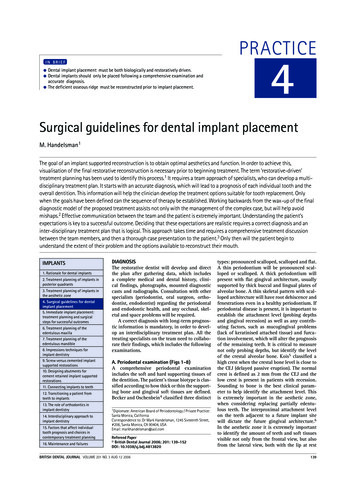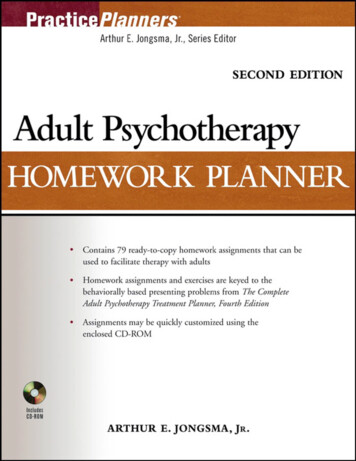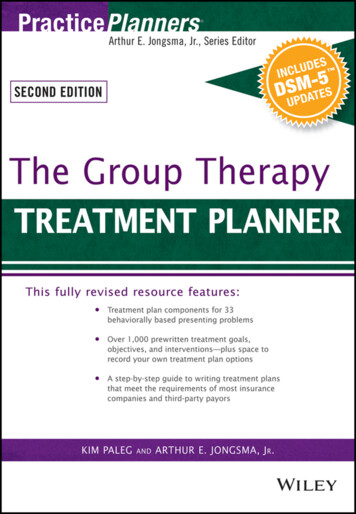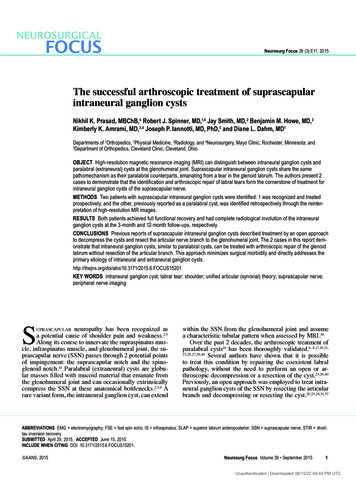
Transcription
neurosurgicalfocusNeurosurg Focus 39 (3):E11, 2015The successful arthroscopic treatment of suprascapularintraneural ganglion cystsNikhil K. Prasad, MBChB,4 Robert J. Spinner, MD,1,4 Jay Smith, MD,2 Benjamin M. Howe, MD,3Kimberly K. Amrami, MD,3,4 Joseph P. Iannotti, MD, PhD,5 and Diane L. Dahm, MD1Departments of 1Orthopedics, 2Physical Medicine, 3Radiology, and 4Neurosurgery, Mayo Clinic, Rochester, Minnesota; and5Department of Orthopedics, Cleveland Clinic, Cleveland, OhioObject High-resolution magnetic resonance imaging (MRI) can distinguish between intraneural ganglion cysts andparalabral (extraneural) cysts at the glenohumeral joint. Suprascapular intraneural ganglion cysts share the samepathomechanism as their paralabral counterparts, emanating from a tear in the glenoid labrum. The authors present 2cases to demonstrate that the identification and arthroscopic repair of labral tears form the cornerstone of treatment forintraneural ganglion cysts of the suprascapular nerve.Methods Two patients with suprascapular intraneural ganglion cysts were identified: 1 was recognized and treatedprospectively, and the other, previously reported as a paralabral cyst, was identified retrospectively through the reinterpretation of high-resolution MR images.Results Both patients achieved full functional recovery and had complete radiological involution of the intraneuralganglion cysts at the 3-month and 12-month follow-ups, respectively.Conclusions Previous reports of suprascapular intraneural ganglion cysts described treatment by an open approachto decompress the cysts and resect the articular nerve branch to the glenohumeral joint. The 2 cases in this report demonstrate that intraneural ganglion cysts, similar to paralabral cysts, can be treated with arthroscopic repair of the glenoidlabrum without resection of the articular branch. This approach minimizes surgical morbidity and directly addresses theprimary etiology of intraneural and extraneural ganglion US15201Key Words intraneural ganglion cyst; labral tear; shoulder; unified articular (synovial) theory; suprascapular nerve;peripheral nerve imagingSuprascapular neuropathy has been recognized asa potential cause of shoulder pain and weakness.2,5Along its course to innervate the supraspinatus muscle, infraspinatus muscle, and glenohumeral joint, the suprascapular nerve (SSN) passes through 2 potential pointsof impingement: the suprascapular notch and the spinoglenoid notch.41 Paralabral (extraneural) cysts are globular masses filled with mucoid material that emanate fromthe glenohumeral joint and can occasionally extrinsicallycompress the SSN at these anatomical bottlenecks.2,5,9 Arare variant form, the intraneural ganglion cyst, can extendwithin the SSN from the glenohumeral joint and assumea characteristic tubular pattern when assessed by MRI.30Over the past 2 decades, the arthroscopic treatment ofparalabral cysts16 has been thoroughly validated.6–8,17,18,21,23,26,27,39,40Several authors have shown that it is possibleto treat this condition by repairing the coexistent labralpathology, without the need to perform an open or arthroscopic decompression or a resection of the cyst.23,26,40Previously, an open approach was employed to treat intraneural ganglion cysts of the SSN by resecting the articularbranch and decompressing or resecting the cyst.20,25,29,31,37Abbreviations EMG electromyography; FSE fast spin echo; IS infraspinatus; SLAP superior labrum anteroposterior; SSN suprascapular nerve; STIR shorttau inversion recovery.submitted April 29, 2015. accepted June 15, 2015.include when citing DOI: 10.3171/2015.6.FOCUS15201. AANS, 2015Neurosurg Focus Volume 39 September 20151Unauthenticated Downloaded 06/15/22 09:44 PM UTC
N. K. Prasad et al.Given the unifying articular theory,32 we predicted that itshould be possible to treat suprascapular intraneural ganglion cysts in the same way as paralabral cysts—with repair of the capsulolabral defect in the joint of origin. Here,we present 2 cases of suprascapular intraneural ganglioncysts, scrutinized with high-resolution MRI and treatedwith arthroscopic repair of an associated paralabral tear,without resection of the articular branch.Illustrative CasesAll retrospective reviewing of patient data was performed under the auspices of the institutional reviewboard at the Mayo Clinic. Both cases were hypothesisdriven. In Case 1, an arthroscopic approach was employedfor the first time for a suprascapular intraneural cyst basedon its analogous nature to a paralabral cyst. Case 2, whichhad been documented13 (and treated) as a paralabral cyst,had the MRI appearance of and was subsequently reinterpreted as an intraneural ganglion cyst.Case 1History and ExaminationA 38-year-old woman presented with a 2-week historyof gradually worsening, atraumatic, right posterior shoulder pain radiating down the arm and associated with paresthesia in the palm. Examination revealed mild denervation atrophy and weakness in the infraspinatus and supraspinatus muscles with preserved function in the deltoid,triceps, wrist and finger extensors, and latissimus dorsimuscles. She had mildly reduced sensation in the volarforearm, and the Tinel sign was positive in the infraclavicular region, radiating to the forearm. Electrodiagnosticstudies were consistent with a suprascapular neuropathyproximal to the suprascapular notch, with denervation,reinnervation, and fibrillations in the infraspinatus andsupraspinatus muscles. There were no electromyography(EMG) abnormalities noted in the ipsilateral deltoid or biceps muscles.The MR image, which was previously described by ourgroup,33 revealed a labral tear posterior to the biceps labralcomplex with a well-defined narrow neck emanating fromthe tear (Fig. 1 left). The cyst traveled along the courseof the SSN through the spinoglenoid and suprascapularnotches, toward the upper trunk of the brachial plexus.The supraspinatus and infraspinatus muscles exhibitedearly signs of denervation with intramuscular edema butno atrophy. All other C5- and C6-innervated muscleswithin the radiological field of view appeared normal.Shoulder MR arthrography demonstrated intraarticularcontrast extending from the labral tear as a narrow neckinto the intraneural cyst (Fig. 1 right). Preoperative ultrasound confirmed these findings and provided a baselinefor comparison with subsequent assessments.TreatmentThe patient underwent an arthroscopic evaluation ofthe right shoulder (Fig. 2). Anterior and posterior arthroscopy portals were used, the former through direct visualization of the rotator interval. No articular surface pathology was identified, but there was extensive fraying ofthe superior labrum, with a tear along the posterosuperiorlabrum extending from the 10 to 12 o’clock position. Aprobe was placed beneath the labral tear to identify thecyst. As the posterosuperior glenoid was rasped in preparation for repair, a small amount of cyst fluid was noted toenter the joint. The labral tear was repaired with the placement of No. 2 sutures in a mattress formation, anchoredto a Bio-SutureTak. The articular branch of the SSN wasnot resected.Posttreatment CourseTwo weeks after surgery, there was 50% resorptionof the cyst as detected by ultrasonography (Fig. 3). By 3months after surgery, MRI revealed complete resolutionof the cyst (Fig. 4) and EMG demonstrated reinnervation.One year postoperatively, there was complete resolutionof the cyst as measured by ultrasonography and MRI. Thepatient made a complete functional recovery.Case 2History and ExaminationA 27-year-old woman was evaluated for right shoulderpain and a nontender mass in the supraclavicular fossa.FIG. 1. Case 1. Preoperative MR images. Left: Axial T1-weighted fastspin echo (FSE) MR image with fat suppression after the administration of intraarticular gadolinium contrast agent demonstrates a tear inthe posterior glenoid labrum with a connection to the paralabral cyst(arrow). Right: Axial T2-weighted FSE MR image with fat suppression after intraarticular gadolinium administration shows an intraneuralcyst (asterisk) arising from the posterior labral tear (not shown) at theshoulder extending through the SSN into the upper trunk of the brachialplexus (arrow).2FIG. 2. Case 1. Intraoperative findings. Left: A posterosuperior labraltear viewed from the posterior portal. Right: Repair of the posterosuperior labral tear viewed from the anterior portal.Neurosurg Focus Volume 39 September 2015Unauthenticated Downloaded 06/15/22 09:44 PM UTC
Arthroscopic treatment of suprascapular intraneural ganglion cystFIG. 3. Case 1. Ultrasound findings 2 weeks postoperatively. Left: Long-axis view of the infraspinatus muscle demonstratespersistence of the spinoglenoid notch cyst (asterisk). The relationship among the cyst, glenoid (G), and scapula (Sc) is clear.Orientation: left medial, right lateral (LAT), top superficial, bottom deep. Right: Short-axis view of the infraspinatus muscledemonstrates persistence of the spinoglenoid notch cyst (asterisk). The relationship among the spine of the scapula (Sp), infraspinatus fossa (Sc), infraspinatus (IS), and posterior deltoid (PD) is clear. Orientation: left caudad, right cephalad (CEPH), top superficial, bottom deep.The shoulder pain was exacerbated by overhead activities, but the patient’s primary concern was the cosmeticappearance of the neck mass. There was no history oftrauma, and the patient was not an athlete. Neurovascularfunction of the right upper limb was intact. MR imagesshowed a ganglion cyst that was thought to be a paralabralcyst13 (Fig. 5) extending from a torn edge of the superiorlabrum anteroposterior (SLAP) Type II to the supraclavicular fossa.TreatmentA combined arthroscopic and open approach wasused—the former to treat the labral tear and the latter toexcise the subcutaneous portion of the cyst with an incision made directly over it. As the pathology was thought tobe extraneural, no attempt was made to resect the articularnerve branch at the time of operation. The resected segment of cyst did not contain any neural tissue.denervation changes in the supraspinatus and infraspinatus muscles, i.e., increased signal on short-tau inversionrecovery (STIR) sequences, consistent with an occult neuropathy of the SSN.DiscussionThe 2 illustrated cases in this study represent an important milestone in our understanding of the pathophysiology and treatment of intraneural ganglia. The cases showthat intraneural ganglion cysts of the shoulder share acommon etiology with paralabral cysts and can be treatedin a similar fashion. These findings are consistent with theunifying theory for intraneural ganglia,34 which explainsthe development of both intraneural and extraneural ganglion cysts (Fig. 8) and allows us to target treatment to theprimum movens (the joint) and predict surgical outcome.While we acknowledge that cyst decompression, either ar-Posttreatment CourseNo electrodiagnostic studies were performed before orafter the operation. The patient achieved functional improvement secondary to relief of shoulder pain, and bothgross and radiological involution of the cyst occurred bythe 3-month follow-up (Fig. 6).The cyst’s morphology was intriguing19 and seemedreminiscent of an intraneural ganglion cyst, with a tubular proximal extension along the course of the SSN. Withthe assistance of the senior author, we were able to obtainall relevant clinical data and the original imaging. Threedimensional reconstructions of the images confirmed oursuspicions that it was an intraneural ganglion cyst with atubular morphology (Fig. 7A and B) and with evidence ofcrossover (in the upper trunk), descent (in the divisions),and ascent as far as the C-5 and C-6 nerves (Fig. 7C). Thelargest collection of cyst fluid appeared to be in a cutaneous branch of the SSN. There was subtle MRI evidence ofFIG. 4. Case 1. Postoperative MR images at 3 months after treatment. Left: Axial T2-weighted FSE MR image with fat suppression(same level as image seen in Fig. 1 left) after repair of the labral tearshows resolution of the tear and cyst. Right: Axial T2-weighted FSEMR image with fat suppression (same level as image seen in Fig. 1 right)after repair of the labrum shows complete resolution of the intraneuralcyst, including extension into the brachial plexus.Neurosurg Focus Volume 39 September 20153Unauthenticated Downloaded 06/15/22 09:44 PM UTC
N. K. Prasad et al.FIG. 5. Case 2. Preoperative MR images. Left: Coronal STIR MR image slightly anterior to the published image13 shows a largecyst (asterisk) within the soft tissues of the right neck extending toward the skin, seemingly remote from the shoulder joint. Theslightly hyperintense brachial plexus (arrows) is immediately deep to the cyst. Right: Axial STIR MR image of the right upperchest shows the large cyst (asterisk) within the SSN with extension anteriorly deep to the clavicle. There is a subtle suggestion ofthe proximal extension of cyst to the cervical roots (straight arrow). The posterior aspect of the cyst (curved arrow) is just superiorto the suprascapular notch.throscopically (Case 1) or with an open approach (Case2), may provide immediate relief of symptoms, we do notbelieve that it is necessary for long-term success of treatment and should not be regarded as the primary therapeutic objective.The most widely accepted theory for the pathogenesisof ganglion cysts is that joint fluid egresses into the para-FIG. 6. Case 2. Postoperative MR image at 2 months after treatment.Axial T2-weighted FSE MR image with fat suppression at the level of theacromion (A; same axial level as in Fig. 1 right) shows no cyst deep tothe clavicle (C) after repair of the labral tear and resection of the mostsuperficial component of the cyst in the neck. The postoperative study isvery limited, performed with a shoulder coil with a small field of view andfew sequences.4articular tissues from a capsulolabral tear. The strength ofthe association between labral tears and both paralabral(extraneural)7–10,17,21,36,39 and intraneural ganglion cysts30has been established. We have also previously demonstrated30 and herein confirmed a similar association betweenposterosuperior labral tears and intraneural ganglion cysts.The intraneural ganglion cysts in Cases 1 and 2 obey thesame principles of formation as previously reported suprascapular intraneural ganglia:20,22,24,25,29–31,37 1) Theyoriginate from the articular nerve branch that supplies asynovial joint; 2) they follow the path of least resistance;and 3) the size, extension, and compressive effect of thecyst fluctuates based on dynamic joint pressures. Theseprinciples also apply to extraneural cysts, except that thejoint connection is via a nonneural pedicle. In Case 1, thesuprascapular intraneural ganglion cyst was identifiedpreoperatively.33 The joint connection was establishedby MRI, and the communication through the labral tearwas documented by MR arthrography. The cyst extendedlongitudinally toward the retroclavicular brachial plexus.Given our experience with this case and others,30,31,33 wewere able to reinterpret the imaging findings of Case 2.The cyst in Case 2 followed the same course as in Case 1,but it extended even more proximally along the brachialplexus (Fig. 7). We believe that the supraclavicular massthat was resected was actually a portion of the intraneuralganglion cyst tracking into a cutaneous branch of the SSN.The existence of this branch, though not widely known,has been demonstrated by several authors1,11,14,38 to consistof fine filaments that ramify with the lateral supraclavicular nerve.1 Given the small caliber of this twig and thelarge cyst, it is understandable that the nerve fascicle wasnot seen in the resected specimen (note that we have seenthis in many cases of resected articular branches of peroneal intraneural ganglia). Alternatively, the subcutaneouscyst may represent extraneural rupture and cyst encapsulation.Neurosurg Focus Volume 39 September 2015Unauthenticated Downloaded 06/15/22 09:44 PM UTC
Arthroscopic treatment of suprascapular intraneural ganglion cystFIG. 7. Case 2. Reinterpreted preoperative MR images. A: Coronal maximum intensity projection (MIP) from a coronal STIR MRimage data set shows the intraneural cyst (asterisk) arising from a labral tear at the shoulder (white arrow), extending within theSSN (black curved arrow) proximally into the neck. The image shows proximal extension of the cyst along C-6 (white arrowheads).The image also shows evidence of descent within the brachial plexus (black arrowhead) from a nexus point (black plus sign) at theinferior aspect of the larger cyst. B: Oblique coronal MIP from a coronal STIR MR image data set slightly anterior to the image inpanel A shows the course of the cyst from the labral tear (white arrow), through the suprascapular cyst (black curved arrow) andinto the larger cyst extending toward the skin (asterisk). There is again evidence for proximal extension along C-6 (white arrowhead) as well as the nexus point (black plus sign), intraneural ascent (white arrowhead), and descent (black arrowhead), as seen inpanel A. C: Axial STIR MR image at the level of C-5 shows a cyst in the right nerve root within the foramen (arrows). The left sideis normal.It has been consistently demonstrated that treating labralpathology leads to cyst involution, regardless of whetherthe cyst is decompressed intraoperatively or not.23,26,40However, decompression of paralabral cysts without addressing the labral tear often leads to recurrence.3,4,12,28,36,39Given these findings, results from the operative treatmentof SSN intraneural ganglia can also be predicted. In bothof the reported cases, there was successful treatment ofintraneural ganglia without resection of the articular nervebranches (intentionally in Case 1 and unknowingly inCase 2). The cyst decompression in Case 1 and the openresection of the subcutaneous portion of the cyst in Case 2were likely not necessary; we believe that the cyst wouldhave spontaneously resolved after labral repair. Addressing the labral tear can replace the need to disconnect thearticular branch to allow cyst resolution and promote neurological recovery. Labral tears may be difficult to identify by preoperative MRI; however, arthrography maybe useful in revealing subtle pathology. We believe thatsuprascapular intraneural ganglia are always associatedwith labral tears, but certain authors have reported otherwise.35 Until now, open surgery has been used to resectintraneural ganglion cysts of the SSN,20,22,24,25,29–31,37 and ifthe associated labral tear is not identified or treated, it isimperative to resect the articular nerve branch. However,failure to address the labral tear may result in suboptimalrecovery and recurrence.30 In summary, the therapeuticobjectives in decreasing order of importance are repairof labral pathology, resection of the cystic articular nervebranch, and decompression of the cyst. Cyst decompression, by itself, may be performed before, during, or aftersurgery to provide symptomatic relief and reduce pressureon the nerve, but it does not address the primary pathol-ogy or prevent recurrence. Our current understanding andsurgical approach represents a paradigm shift.Much of what we have learned about intraneural ganglion cysts has been extrapolated from cases affecting themost common site of occurrence—the common peronealnerve at the superior tibiofibular joint. The small size ofthis joint makes arthroscopic exploration difficult. Thelarger joint cavities associated with shoulder- and hipderived intraneural ganglia offer the opportunity to studythe condition from an arthroscopic perspective. Generalexperience in cases at the shoulder confirms the jointrelated pathogenesis of these cysts and the advantages ofthe arthroscopic approach (i.e., direct, safe treatment ofthe labral tear and indirect, effective treatment of the intraneural cyst and neuropathy). We uncovered, at the acetabulofemoral joint, a single case of an arthroscopicallytreated “perineural cyst” of the sciatic nerve near the hipjoint.15 The authors of that published study believed thatthe cyst was extraneural, and they simply excised the cystwall. However, we believe that the cyst was intraneuraland that there is likely to have been associated acetabularlabral pathology that was not addressed. Likewise, otherparalabral cysts at the shoulder region may well be intraneural ganglion cysts, as in our Case 2.ConclusionsRare suprascapular intraneural ganglion cysts have acharacteristic clinical and radiological pattern. In keepingwith the unifying articular theory, intraneural ganglioncysts share the same clear principles of formation andtreatment as the more common paralabral cysts. Learningfrom current treatment algorithms for paralabral cysts, weNeurosurg Focus Volume 39 September 20155Unauthenticated Downloaded 06/15/22 09:44 PM UTC
N. K. Prasad et al.4.5.6.7.8.9.10.11.12.13.14.15.FIG. 8. Anatomical path of the SSN, giving off a superior articularbranch to the SSN at the suprascapular notch and an inferior articularbranch at the spinoglenoid notch. Ganglion cysts can extend along anextraneural (paralabral) or intraneural (superior and inferior articularbranches) route. The only way to prevent recurrence is by repairing thelabral tear. Adapted from Spinner et al: J Neurosurg 104:551–557, 2006.Used with permission of the Mayo Foundation for Medical Educationand Research. All rights reserved.16.17.18.believe that intraneural ganglia can be managed withoutresection of the articular nerve branch or decompressionof the cyst, which will gradually involute over time if thecausative labral tear is repaired.19.Acknowledgments21.We appreciate the assistance of Alexandra P. Wolanskyj, MD,and David Factor of Rochester, Minnesota.References1. Ajmani ML: The cutaneous branch of the human suprascapular nerve. J Anat 185:439–442, 19942. Antoniou J, Tae SK, Williams GR, Bird S, Ramsey ML,Iannotti JP: Suprascapular neuropathy. Variability in thediagnosis, treatment, and outcome. Clin Orthop Relat Res(386):131–138, 20013. Baums MH, Seil R, Kettler M, Steckel H, Schultz W, KlingerHM: Treatment option in a SLAP-related ganglion cyst re-620.22.23.24.sulting in suprascapular nerve entrapment. Arch OrthopTrauma Surg 126:621–623, 2006Biedert RM: Atrophy of the infraspinatus muscle caused by asuprascapular ganglion. Clin J Sport Med 6:262–264, 1996Boykin RE, Friedman DJ, Higgins LD, Warner JJ: Suprascapular neuropathy. J Bone Joint Surg Am 92:2348–2364,2010Chen AL, Ong BC, Rose DJ: Arthroscopic management ofspinoglenoid cysts associated with SLAP lesions and suprascapular neuropathy. Arthroscopy 19:E15–E21, 2003Chochole MH, Senker W, Meznik C, Breitenseher MJ:Glenoid-labral cyst entrapping the suprascapular nerve: dissolution after arthroscopic debridement of an extended SLAPlesion. Arthroscopy 13:753–755, 1997Fehrman DA, Orwin JF, Jennings RM: Suprascapular nerveentrapment by ganglion cysts: a report of six cases with arthroscopic findings and review of the literature. Arthroscopy11:727–734, 1995Ferretti A, Cerullo G, Russo G: Suprascapular neuropathy involleyball players. J Bone Joint Surg Am 69:260–263, 1987Hadley MN, Sonntag VK, Pittman HW: Suprascapularnerve entrapment. A summary of seven cases. J Neurosurg64:843–848, 1986Harbaugh KS, Swenson R, Saunders RL: Shoulder numbnessin a patient with suprascapular nerve entrapment syndrome:cutaneous branch of the suprascapular nerve: case report.Neurosurgery 47:1452–1456, 2000Hashimoto BE, Hayes AS, Ager JD: Sonographic diagnosisand treatment of ganglion cysts causing suprascapular nerveentrapment. J Ultrasound Med 13:671–674, 1994Ho JC, Iannotti JP: Glenoid labral tear associated paralabralganglion cyst presenting as a neck mass: a case report. JShoulder Elbow Surg 19:e10–e13, 2010Horiguchi M: The cutaneous branch of some human suprascapular nerves. J Anat 130:191–195, 1980Hwang DS, Kang C, Lee JB, Cha SM, Yeon KW: Arthroscopic treatment of piriformis syndrome by perineuralcyst on the sciatic nerve: a case report. Knee Surg SportsTraumatol Arthrosc 18:681–684, 2010Iannotti JP, Ramsey ML: Arthroscopic decompression of aganglion cyst causing suprascapular nerve compression. Arthroscopy 12:739–745, 1996Kessler MA, Stoffel K, Oswald A, Stutz G, Gaechter A: TheSLAP lesion as a reason for glenolabral cysts: a report of fivecases and review of the literature. Arch Orthop TraumaSurg 127:287–292, 2007Lichtenberg S, Magosch P, Habermeyer P: Compression ofthe suprascapular nerve by a ganglion cyst of the spinoglenoid notch: the arthroscopic solution. Knee Surg SportsTraumatol Arthrosc 12:72–79, 2004Mallon WJ: Editor’s note. J Shoulder Elbow Surg 19:633–634, 2010Mizuno K, Usui Y, Harada Y, Hirohata K: Infraspinatus muscle paralysis due to epineural ganglion of the suprascapularnerve. Jpn J Rheum Joint Surg 9:521–526, 1990Moore TP, Fritts HM, Quick DC, Buss DD: Suprascapularnerve entrapment caused by supraglenoid cyst compression. JShoulder Elbow Surg 6:455–462, 1997Nägele M, Lienemann A, Hahn D, Witt T: [Intraneuronalganglia: value of diagnostic radiologic possibilities.] DigitaleBilddiagn 8:14–17, 1988 (Ger)Piatt BE, Hawkins RJ, Fritz RC, Ho CP, Wolf E, Schickendantz M: Clinical evaluation and treatment of spinoglenoidnotch ganglion cysts. J Shoulder Elbow Surg 11:600–604,2002Rezzouk J, Durandeau A: [Nerve compression by mucoidpseudocysts: arguments favoring an articular cause in 23patients.] Rev Chir Orthop Reparatrice Appar Mot90:143–146, 2004 (Fr)Neurosurg Focus Volume 39 September 2015Unauthenticated Downloaded 06/15/22 09:44 PM UTC
Arthroscopic treatment of suprascapular intraneural ganglion cyst25. Sanger J, Cortes W, Yan JG: Intraneural ganglion of the suprascapular nerve: case report. J Hand Surg Am 31:40–44,200626. Schroder CP, Skare O, Stiris M, Gjengedal E, Uppheim G,Brox JI: Treatment of labral tears with associated spinoglenoid cysts without cyst decompression. J Bone Joint SurgAm 90:523–530, 200827. Shon MS, Jung SW, Kim JW, Yoo JC: Arthroscopic all-intraarticular decompression and labral repair of paralabral cystin the shoulder. J Shoulder Elbow Surg 24:e7–e14, 201528. Skirving AP, Kozak TK, Davis SJ: Infraspinatus paralysisdue to spinoglenoid notch ganglion. J Bone Joint Surg Br76:588–591, 199429. Spinner RJ, Amrami KK: Intraneural ganglion of the suprascapular nerve: Case report. J Hand Surg Am 31:1698–1699,200630. Spinner RJ, Amrami KK, Kliot M, Johnston SP, Casañas J:Suprascapular intraneural ganglia and glenohumeral jointconnections. J Neurosurg 104:551–557, 200631. Spinner RJ, Amrami KK, Wang H, Kliot M, CarmichaelSW: Cross-over: a generalizable phenomenon necessary forsecondary intraneural ganglion cyst formation. Clin Anat21:111–118, 200832. Spinner RJ, Atkinson JL, Tiel RL: Peroneal intraneuralganglia: the importance of the articular branch. A unifyingtheory. J Neurosurg 99:330–343, 200333. Spinner RJ, Hébert-Blouin MN, Dahm DL, Amrami KK:Two different pathways for suprascapular intraneural ganglion cysts along two distinct articular branches from theglenohumeral joint. Clin Anat 23:462–465, 201034. Spinner RJ, Scheithauer BW, Amrami KK: The unifyingarticular (synovial) origin of intraneural ganglia: evolutionrevelation-revolution. Neurosurgery 65 (4 Suppl):A115–A124, 200935. Sureka J, Panwar S: MR imaging of suprascapular neuropathies. J Musculoskelet Res 15:1230003, 201236. Tirman PF, Feller JF, Janzen DL, Peterfy CG, Bergman AG:Association of glenoid labral cysts with labral tears and glenohumeral instability: radiologic findings and clinical significance. Radiology 190:653–658, 199437. Usui Y, Harada Y, Mizuno K, Hirohata K: Infraspinatusparalysis by a suspected intraneural ganglion. A case report.Rinnshouseikei 20:887–891, 198538. Vorster W, Lange CP, Briët RJ, Labuschagne BC, du ToitDF, Muller CJ, et al: The sensory branch distribution of thesuprascapular nerve: an anatomic study. J Shoulder ElbowSurg 17:500–502, 200839. Westerheide KJ, Dopirak RM, Karzel RP, Snyder SJ: Suprascapular nerve palsy secondary to spinoglenoid cysts: resultsof arthroscopic treatment. Arthroscopy 22:721–727, 200640. Youm T, Matthews PV, El Attrache NS: Treatment of patientswith spinoglenoid cysts associated with superior labral tearswithout cyst aspiration, debridement, or excision. Arthroscopy 22:548–552, 200641. Zehetgruber H, Noske H, Lang T, Wurnig C: Suprascapularnerve entrapment. A meta-analysis. Int Orthop 26:339–343,2002DisclosureDr. Smith owns stock in Sonex Health and Tenex Health; holdsa patent with Tenex Health; holds a license agreement withTenex Health; and is the chief medical officer of Sonex Health.Dr. Iannotti holds a patent with the Cleveland Clinic and DePuySynthes.Author ContributionsConception and design: Spinner, Smith, Dahm. Acquisition ofdata: Spinner, Smith, Howe, Iannotti, Dahm. Analysis and interpretation of data: Spinner, Prasad, Howe, Amrami, Dahm. Drafting the article: all authors. Critically revising the article: Spinner,Prasad, Smith, Dahm. Reviewed submitted version of manuscript:Spinner, Prasad. Study supervision: Spinner.CorrespondenceRobert J. Spinner, Mayo Clinic, Gonda 8-214S, Rochester, MN55905. email: spinner.robert@mayo.edu.Neurosurg Focus Volume 39 September 20157Unauthenticated Downloaded 06/15/22 09:44 PM UTC
formed under the auspices of the institutional review board at the Mayo Clinic. Both cases were hypothesis driven. In Case 1, an arthroscopic approach was employed for the first time for a suprascapular intraneural cyst based on its analogous nature to a paralabral cyst. Case 2, which had been documented13 (and treated) as a paralabral cyst,



